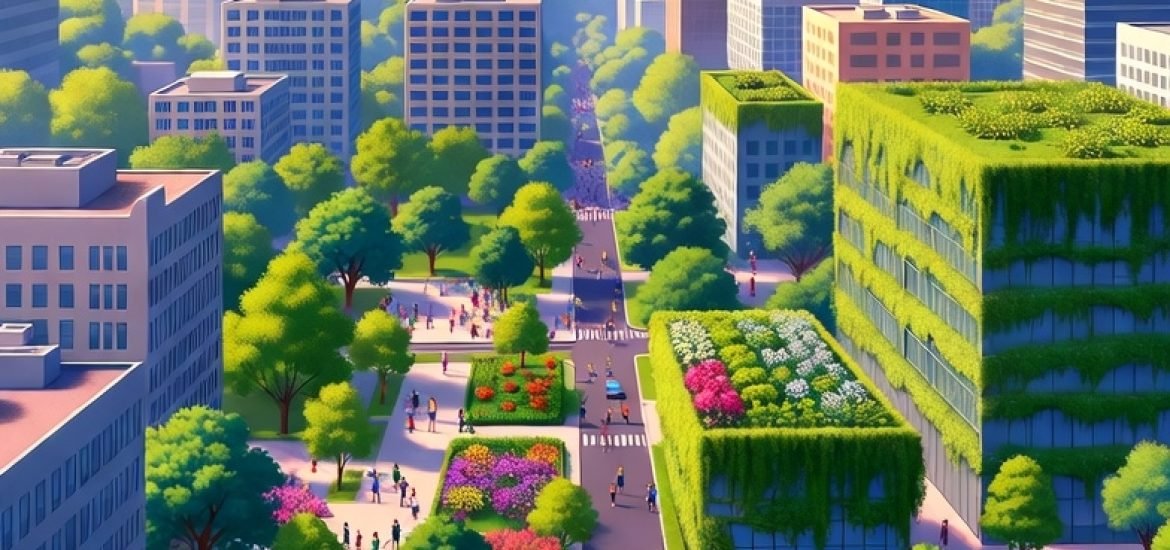Post-Growth Economy Reflections: Reimagining Prosperity through Regenerative Cities – European Scientist

Report on Post-Growth Economic Models and Regenerative Cities in the Context of the Sustainable Development Goals (SDGs)
Introduction: Systemic Shifts Towards a Wellbeing Economy
The prevailing economic growth paradigm is facing scrutiny for its inability to deliver sustainable and equitable outcomes, challenging the achievement of the United Nations’ Sustainable Development Goals (SDGs). This report examines the necessity of a systemic shift from a growth-oriented trajectory to a wellbeing-focused, post-growth equilibrium. Such a transition requires moving beyond incremental adjustments, like efficiency gains, which are often insufficient to address deep-seated ecological and social imbalances. The focus is on reorienting economic priorities from material expansion to sustaining prosperity through the integration of natural, built, human, and social capital, a framework that directly supports a holistic implementation of the SDGs.
Urbanisation and its Role in Sustainable Development
The Urban Challenge to the SDGs
Urbanisation presents a complex dynamic in the pursuit of sustainable development. Cities have historically functioned as extractive systems, posing significant challenges to several SDGs:
- SDG 12 (Responsible Consumption and Production): Cities concentrate consumption, drawing resources from vast hinterlands and generating significant waste.
- SDG 15 (Life on Land): Urban sprawl often leads to the degradation of ecosystems and loss of biodiversity.
- SDG 11 (Sustainable Cities and Communities): The conventional model of urban expansion can create fragile, inequitable communities dependent on unsustainable supply chains.
Cities as Hubs for SDG Innovation
Despite these challenges, cities are also critical arenas for innovation and can serve as catalysts for achieving the SDGs. By concentrating opportunities for resource recovery and social innovation, urban areas can pioneer new models of living. The re-emergence of proximity-based logic, such as localized food production and shorter supply chains, signals a potential shift. This reinvention of spatial economics aligns with a post-growth paradigm where cities transform from resource consumers into regenerative ecosystems, directly contributing to:
- SDG 2 (Zero Hunger): By re-embedding agriculture within urban life.
- SDG 11 (Sustainable Cities and Communities): By fostering resilient and self-sufficient urban environments.
- SDG 8 (Decent Work and Economic Growth): By creating new economic models based on sufficiency, participation, and regeneration rather than extraction.
Urban Agriculture: A Catalyst for a Post-Growth Transition
Aligning with Key Sustainable Development Goals
Urban agriculture serves as both a practical mechanism and a powerful symbol for a transition towards a wellbeing economy. It directly addresses multiple SDGs by altering material flows, land use, and social relations.
- SDG 2 (Zero Hunger) & SDG 3 (Good Health and Well-being): It enhances food security and provides access to nutritious food, while fostering community engagement and physical activity.
- SDG 12 (Responsible Consumption and Production): It promotes the concept of ‘prosumers’—citizens who are both producers and consumers—thereby shortening supply chains and fostering a culture of sufficiency.
- SDG 11 (Sustainable Cities and Communities): It reweaves relationships between people and land, consumption and production, and cities and their ecosystems, enhancing social cohesion and community resilience.
Redefining Prosperity Beyond GDP
The Need for New Metrics Aligned with the SDGs
The conventional definition of prosperity, measured by Gross Domestic Product (GDP), is disconnected from genuine human flourishing and ecological stability. This metric fails to account for critical dimensions of wellbeing, undermining progress on the SDGs. A transition towards sustainability requires alternative metrics that integrate economic, ecological, and social factors. This aligns with a systems view where prosperity is defined by balance and resilience across all forms of capital, ensuring that progress in one area does not come at the expense of another.
A new compass for prosperity would track progress towards:
- SDG 8 (Decent Work and Economic Growth): Focusing on job quality, work-life balance, and community-serving roles rather than just employment numbers.
- SDG 3 (Good Health and Well-being): Measuring social cohesion, meaningful lives, and mental health.
- SDG 13 (Climate Action) & SDG 15 (Life on Land): Valuing natural capital and ecosystem services as foundational to wellbeing.
Regenerative Cities: A Framework for Integrated SDG Implementation
Circular Systems for Urban Sustainability
The concept of the regenerative city offers a powerful counter-narrative to the extractive urban model. It emphasizes circularity and resource efficiency, which are central to achieving the SDGs.
- Water Management (SDG 6: Clean Water and Sanitation): A circular approach reframes water scarcity as an opportunity for innovation, turning wastewater into a valuable resource for urban agriculture. This reduces environmental discharge and builds resilience.
- Waste as a Resource (SDG 12: Responsible Consumption and Production): Regenerative cities foster systems for recycling organic waste into valuable inputs for local food production, closing resource loops.
Cultivating a Sustainable Future
Regenerative urban practices, such as community gardens and rooftop farms, are foundational steps toward a future where prosperity is cultivated, not extracted. While not a panacea, urban agriculture exemplifies a broader shift towards an economy centered on ecological integrity, social cohesion, and system resilience. This approach moves beyond technical optimization to address the cultural and narrative dimensions of sustainability. It fosters a vision for achieving the SDGs where ‘grey’ and ‘green’ infrastructures are integrated, and inclusive wellbeing is nurtured from the ground up, reminding us that a sustainable future can be cultivated in the soil beneath our feet.
Analysis of Sustainable Development Goals in the Article
1. Which SDGs are addressed or connected to the issues highlighted in the article?
The article on post-growth economies and regenerative cities connects to several Sustainable Development Goals by critiquing the current growth-centric paradigm and proposing urban agriculture as a model for a systemic shift towards wellbeing and sustainability. The following SDGs are addressed:
-
SDG 2: Zero Hunger
The article’s focus on “localised food production,” “shorter supply chains,” and “urban agriculture” directly relates to creating resilient and sustainable food systems. It discusses re-embedding agriculture within urban life to transform cities from consumers into productive ecosystems, which is relevant to food security and sustainable agricultural practices.
-
SDG 6: Clean Water and Sanitation
The text explicitly discusses water management in the context of urban agriculture. It highlights how circularity can turn “wastewater into a resource that can sustain urban farming,” contrasting this with the linear “take, make, dispose” model. This directly addresses the sustainable management of water and sanitation.
-
SDG 8: Decent Work and Economic Growth
This SDG is addressed primarily through a critical lens. The article questions the conventional definition of economic growth (“rising output, faster flows”) and argues that it has become “disconnected from flourishing.” It advocates for decoupling wellbeing from resource consumption and reorienting priorities from material expansion to sustaining prosperity, which aligns with the goal of promoting sustainable economic models. It also suggests alternative metrics for prosperity beyond employment numbers, such as “job quality, work-life balance, or social cohesion.”
-
SDG 11: Sustainable Cities and Communities
This is a central theme of the article. The entire concept of “Regenerative Cities” and the role of urban agriculture in transforming urban spaces are at the core of SDG 11. The article discusses making cities more resilient, inclusive, and sustainable by fostering community engagement, recycling waste, and rethinking the relationship between urban areas and their surrounding ecosystems.
-
SDG 12: Responsible Consumption and Production
The article directly challenges “entrenched consumption patterns” and the “culture addicted to more.” It promotes a shift towards “sufficiency rather than accumulation” and “regeneration rather than extraction.” The discussion on resource recovery, recycling waste, and shorter supply chains are all central tenets of sustainable consumption and production.
-
SDG 15: Life on Land
The article addresses the negative impacts of urbanization on land, noting that urban expansion “displaces farmland and accelerates deforestation.” By promoting urban agriculture and reweaving relationships “between cities and ecosystems,” it advocates for practices that protect and restore terrestrial ecosystems and halt biodiversity loss by reducing the ecological footprint of cities.
2. What specific targets under those SDGs can be identified based on the article’s content?
Based on the article’s discussion, several specific SDG targets can be identified:
-
SDG 2: Zero Hunger
- Target 2.4: By 2030, ensure sustainable food production systems and implement resilient agricultural practices that increase productivity and production, that help maintain ecosystems… The article’s promotion of urban agriculture as a way to “re-embedding of agriculture within urban life” and create “fertile ecosystems” directly supports this target.
-
SDG 6: Clean Water and Sanitation
- Target 6.3: By 2030, improve water quality by reducing pollution… and substantially increasing recycling and safe reuse globally. The article explicitly supports this by advocating for circular models that turn “wastewater into a resource that can sustain urban farming.”
- Target 6.4: By 2030, substantially increase water-use efficiency across all sectors… The discussion on water as one of agriculture’s “sharpest constraints” and using circularity to reframe scarcity implies a need for greater water-use efficiency.
-
SDG 8: Decent Work and Economic Growth
- Target 8.4: Improve progressively, through 2030, global resource efficiency in consumption and production and endeavor to decouple economic growth from environmental degradation. The article’s central argument that “resource use and GDP are tightly coupled” while “the relationship between resource footprints and quality of life is logarithmic” is a direct call to achieve this decoupling.
-
SDG 11: Sustainable Cities and Communities
- Target 11.3: By 2030, enhance inclusive and sustainable urbanization and capacity for participatory, integrated and sustainable human settlement planning and management. The promotion of urban agriculture as a practice that “foster[s] community engagement” and involves citizens as “‘prosumers’ – citizens who are both producers and consumers” aligns with this target.
- Target 11.6: By 2030, reduce the adverse per capita environmental impact of cities, including by paying special attention to air quality and municipal and other waste management. The article’s focus on “recycling waste” and creating opportunities for “resource recovery” in cities directly addresses this target.
- Target 11.a: Support positive economic, social and environmental links between urban, peri-urban and rural areas. The article reimagines the relationship between cities and their hinterlands, moving away from an extractive model to one where cities can become more self-sufficient and integrated with their surrounding ecosystems.
-
SDG 12: Responsible Consumption and Production
- Target 12.2: By 2030, achieve the sustainable management and efficient use of natural resources. The critique of the growth paradigm that “undermines the ground beneath it” and the call for a “post-growth wellbeing regime” are directly linked to this target.
- Target 12.5: By 2030, substantially reduce waste generation through prevention, reduction, recycling and reuse. The article’s emphasis on moving beyond a “‘take, make, dispose’ model” to one of “circularity” and “recycling waste” is a clear reflection of this target.
-
SDG 15: Life on Land
- Target 15.9: By 2020, integrate ecosystem and natural capital values into national and local planning, development processes… The article’s argument for reorienting priorities to sustain prosperity through the “interaction of natural capital and its ecosystem services with built, human, and social forms of capital” directly supports this integration.
3. Are there any indicators mentioned or implied in the article that can be used to measure progress towards the identified targets?
Yes, the article critiques traditional indicators and suggests or implies several alternative ones:
- Critique of Existing Indicators: The article explicitly states that traditional economic indicators like GDP are insufficient. It notes, “Gadgets sold and concrete poured to build taller skylines tell us little about whether lives are meaningful. Similarly, counting how many people are in employment obscures more than it reveals.”
- Proposed Alternative Indicators: The article suggests a need for new metrics that measure wellbeing more holistically.
- Social Indicators: It proposes that “A useful compass would track job quality, work-life balance, or social cohesion.” These can be developed into measurable indicators to track progress towards a wellbeing economy.
- Integrated Capital Indicators: It refers to alternative metrics that “integrate economic, ecological, and social dimensions,” where wellbeing is measured by the balanced advancement of “engineered and human, environmental, and cultural” capital.
- Implied Quantitative Indicators: Based on the article’s focus areas, several indicators are implied for measuring progress:
- Resource Footprints: The article mentions the tight coupling of “resource use and GDP” and the logarithmic relationship between “resource footprints and quality of life,” implying that measuring resource footprints is a key indicator for decoupling (Target 8.4).
- Waste Recycling Rates: The emphasis on “recycling waste” and moving away from a “take, make, dispose” model implies that the percentage of municipal waste recycled or reused would be a key indicator (Targets 11.6 and 12.5).
- Water Reuse Rates: The discussion of “turning wastewater into a resource” suggests that the volume or percentage of treated wastewater safely reused in agriculture is a relevant indicator (Target 6.3).
- Land Use for Urban Agriculture: The promotion of urban farming implies that the area of urban land dedicated to food production could be an indicator of progress towards more resilient and self-sufficient cities (Targets 2.4 and 11.3).
4. Create a table with three columns titled ‘SDGs, Targets and Indicators” to present the findings from analyzing the article.
| SDGs | Targets | Indicators (Mentioned or Implied in the Article) |
|---|---|---|
| SDG 2: Zero Hunger | 2.4: Ensure sustainable food production systems and implement resilient agricultural practices. | Area of land dedicated to urban and peri-urban agriculture. |
| SDG 6: Clean Water and Sanitation | 6.3: Improve water quality and increase recycling and safe reuse. 6.4: Increase water-use efficiency. |
Volume/percentage of treated wastewater safely reused in urban farming. |
| SDG 8: Decent Work and Economic Growth | 8.4: Decouple economic growth from environmental degradation. | Resource footprints; alternative metrics like job quality, work-life balance, and social cohesion (as opposed to GDP). |
| SDG 11: Sustainable Cities and Communities | 11.3: Enhance inclusive and sustainable urbanization. 11.6: Reduce the adverse per capita environmental impact of cities (esp. waste management). 11.a: Support positive links between urban, peri-urban and rural areas. |
Measures of community engagement in planning; municipal waste recycling rates; percentage of food consumed that is produced locally. |
| SDG 12: Responsible Consumption and Production | 12.2: Achieve sustainable management and efficient use of natural resources. 12.5: Substantially reduce waste generation through recycling and reuse. |
Rate of resource consumption per capita; waste generation per capita; national recycling rates. |
| SDG 15: Life on Land | 15.9: Integrate ecosystem and biodiversity values into national and local planning. | Composite indices measuring the stock of natural, human, and social capital; reduction in urban ecological footprint. |
Source: europeanscientist.com
What is Your Reaction?
 Like
0
Like
0
 Dislike
0
Dislike
0
 Love
0
Love
0
 Funny
0
Funny
0
 Angry
0
Angry
0
 Sad
0
Sad
0
 Wow
0
Wow
0
















































:focal(1500,1000)/https://media.globalcitizen.org/a6/9a/a69a4720-d8a1-4715-b596-18738d03c05c/rotary_polio_hero_image.jpg?#)







/countries/sri-lanka/photo-credit---dmc-sri-lanka.tmb-1200v.jpg?sfvrsn=dc298bcc_1#)



















